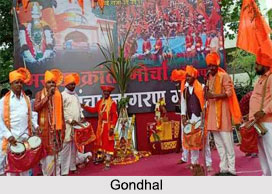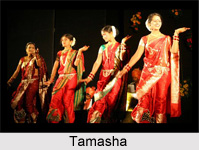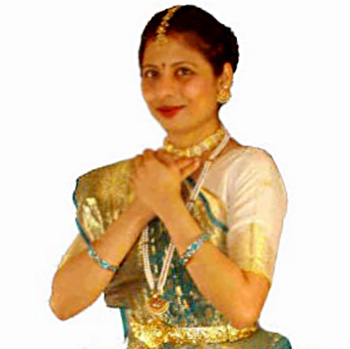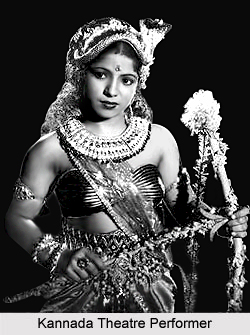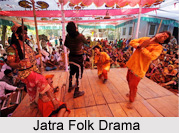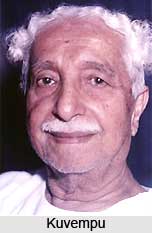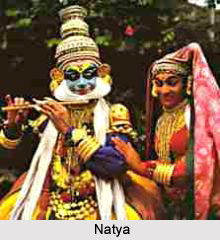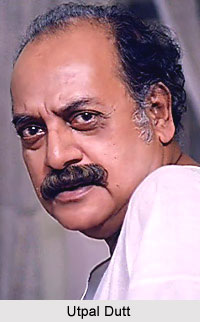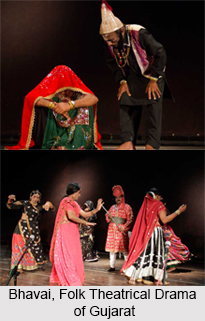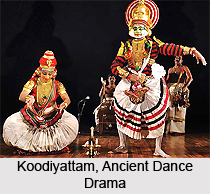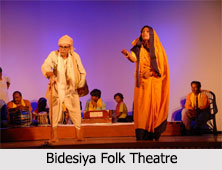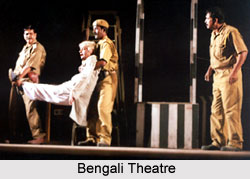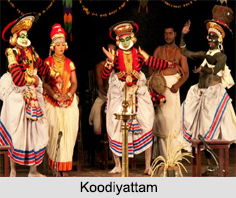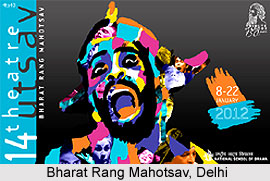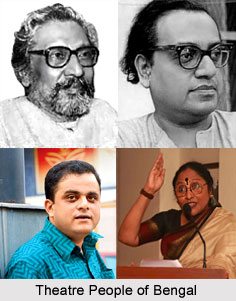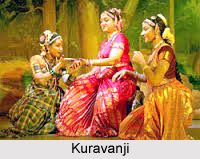 Kuravanji Natakam i.e. `Drama of Kuravanji` is actually Tamil dance-drama. Kuram, Kuravanji, and Kuluvam are more or less synonymous. Kuravan and Kuravanji or Kuratti are respectively the male and female gypsies who appear in ancient Tamil literature, sculpture, ballads, stories, and Bharatanatyam dances. The form deals with the relationship of these hill tribes with their landscape. The narrative rests on the dialogue between the two characters. In the eighteenth century, writing Kuravanji as a literary genre came into vogue. The authors also elevated the gypsy couple into god and goddess. The evidence provides that Kuravanji was performed in the court of the Maratha kings ruling Thanjavur during 1674-1855. This can be found from a reference in Sivakkozhundu Desikar`s Tanjai Sambendra pubala kuravanji i.e. `Kuravanji Praising Sarabendra of Tanjai`. This text has the Maratha king Sarabendra as its hero and is said to have been staged as a musical dance. The famous Thanjavur brothers Chinnaiah born in 1802, Ponnaiah born 1804, Sivanandam born in 1808, and Vadivelu born in 1810 composed its music. Their family retains this tradition of performance. Rukmini Devi-Arundale (1904-86) choreographed some Kuravanji plays as ballets, reviving old texts like Rajappa Kavirayar`s eighteenth-century Kurrala kuravanji i.e. Kuravanji of Kurrala`, in 1944. P. R. Thilagam was an innovative recent exponent.
Kuravanji Natakam i.e. `Drama of Kuravanji` is actually Tamil dance-drama. Kuram, Kuravanji, and Kuluvam are more or less synonymous. Kuravan and Kuravanji or Kuratti are respectively the male and female gypsies who appear in ancient Tamil literature, sculpture, ballads, stories, and Bharatanatyam dances. The form deals with the relationship of these hill tribes with their landscape. The narrative rests on the dialogue between the two characters. In the eighteenth century, writing Kuravanji as a literary genre came into vogue. The authors also elevated the gypsy couple into god and goddess. The evidence provides that Kuravanji was performed in the court of the Maratha kings ruling Thanjavur during 1674-1855. This can be found from a reference in Sivakkozhundu Desikar`s Tanjai Sambendra pubala kuravanji i.e. `Kuravanji Praising Sarabendra of Tanjai`. This text has the Maratha king Sarabendra as its hero and is said to have been staged as a musical dance. The famous Thanjavur brothers Chinnaiah born in 1802, Ponnaiah born 1804, Sivanandam born in 1808, and Vadivelu born in 1810 composed its music. Their family retains this tradition of performance. Rukmini Devi-Arundale (1904-86) choreographed some Kuravanji plays as ballets, reviving old texts like Rajappa Kavirayar`s eighteenth-century Kurrala kuravanji i.e. Kuravanji of Kurrala`, in 1944. P. R. Thilagam was an innovative recent exponent.
The main theme in a Kuravanji is the love and affection of the female protagonist towards the deity of the temple or the local ruler. She pleads to the god of love to fulfill her wish. During the performance, she praises the local deity and glorifies the land. She also requests her maids to bring her lover to her. The scenes are enacted in a dancing form. Apart from the actors, there are additional dancers and musicians. There are numerous variations in this art form. There are compositions with high poetic quality like the `Thirukkutrala Kuravanji`. Some varieties like `Viralimalai Kuravanji` are famous for their music. There is a balancing of music and literature in the `Azhagar` and `Thirumalai Andavar `varieties. A common theme in most of the `Kuravanji` dramas, like in the `Sendil Kuravanji`, is a gypsy woman who appears on the scene and describes the prosperity of the land through songs. She reads the palm of the heroine and predicts the fulfillment of her desires. The form is also referred to as kuram and kuluva natakam.
At least sixty Kuravanji scripts survive, some in print and some in palm-leaf manuscripts. The plays start with a princess who falls in love with a prince while he passes by in the street during his nagar valam i.e. `tour of the city`. She pines for his love and her parents seek the help of the gypsy to prophesy her future. The gypsy reads the princess`s palm, identifies the source of her worries, and predicts a happy future. Meanwhile the gypsy`s partner comes in search of her and they unite after playful dalliance. The gypsy woman comes across as a powerful character with knowledge, skills, mobility, and selfhood. Kuravanji must be seen in the broader context of minor literature like Pallu, which attempted to represent the voice of marginalized communities in society.
